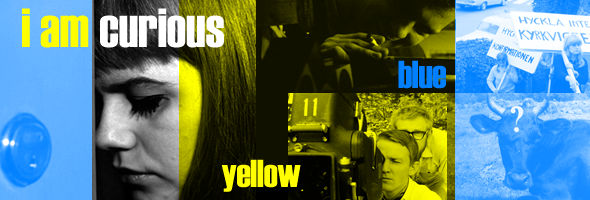
B&W, 1967/1968, 121/107 mins. / Directed by Vilgot Sjöman / Starring Lena Nyman, Börje Ahlstedt / Criterion
The first and more notorious installment, I Am Curious - Yellow (Jag är nyfiken - gul), conveys the world through the eyes of young Lena (Lena Nyman), a fledgling revolutionary whose budding sexuality and innate curiosity lead her on an
For the Yellow disc, supplements include a video interview with publisher Barney Rosset and attorney Edward de Grazia, the two primary figures in the string of legal cases ignited by the film, as well as "The Battle for I Am Curious - Yellow, a video document covering the legal skirmishes. Sjöman appears in a newly recorded video introduction, including a quick look at the studio where he cut his directorial teeth. He also provides commentary for a variety of scenes, in a manner similar to the M2K Claude Chabrol discs in France. The disc also includes an informative essay by Gary Giddins, who rightly points out the film's influence on Medium Cool and the work of Dusan Makavejev, among others. The Blue disc repeats the Sjöman commentary method and also features a condensed version of Self Portrait '92, a Swedish television documentary about the director in which he comes off as something of a crackpot. Other bonuses include a deleted scene (nice but don't except anything revelatory) and text excerpts from a 1968 interview with the director, shortly before the American controversy really broke the following year.
Best known as a cinematic catchphrase for cinematic naughtiness and liberation, "I Am Curious" refers to a pair of semi-experimental features by Swedish director Vilgot Sjöman. A fascinating if uneven stew of radical politics, kitchen sink realism, sexual frankness, and gritty documentary techniques, these films serve as effective celluloid time capsules even after the shock value has largely dissipated over time.
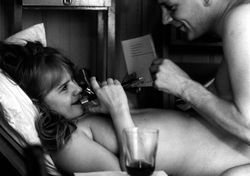 eye-opening journey through her country, while the filmmakers and crew are reflected in what amounts to a blurring between art and reality. Lena commences a passionate but troubled relationship with car salesman Börje Ahlstedt (mirrored in the film and real life by a tumultuous triangle with director Vilgot Sjöman), and their experiences range from idyllic weekends together in the country to a far more clinical awakening at a health camp for reactionaries. Lena's story continues with I Am Curious - Blue (Jag är nyfiken - bla), a far less controversial study of Swedish society via social norms, the penal system, religious doctrine, and domestic relationships, as Nyman and Ahlstedt attempt to ground their lives in an increasing atmosphere of unrest.
eye-opening journey through her country, while the filmmakers and crew are reflected in what amounts to a blurring between art and reality. Lena commences a passionate but troubled relationship with car salesman Börje Ahlstedt (mirrored in the film and real life by a tumultuous triangle with director Vilgot Sjöman), and their experiences range from idyllic weekends together in the country to a far more clinical awakening at a health camp for reactionaries. Lena's story continues with I Am Curious - Blue (Jag är nyfiken - bla), a far less controversial study of Swedish society via social norms, the penal system, religious doctrine, and domestic relationships, as Nyman and Ahlstedt attempt to ground their lives in an increasing atmosphere of unrest.
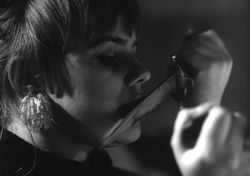 Named for the two colors of the Swedish flag, the I Am Curious films are especially interesting for their hall of mirrors approach to filmmaking. Newsreel footage of real figures like Martin Luther King, Jr. mixes with scribbled onscreen slogans, interviews with common people on the street, and a semblance of a linear narrative. The decidedly non-glamorous Lena was something of a shock at the time; her pale and "normal" figure certainly clash with the ideal of Twiggy and Audrey Hepburn being promoted at the time (to say nothing of where we are today). Sjöman describes the films as concurrent versions of the same story, simply told with different materials; in fact, they were both assembled from one huge mound of film shot in 1966 after the director decided to make an independent project freed from Swedish studio restraints. Of course, few could have predicted the seismic international remifications of his little cinematic statement; the film was banned in the U.S. and taken all the way to the Supreme Court to be tried for obscenity. Thanks to the legal watersheds inaugurated
Named for the two colors of the Swedish flag, the I Am Curious films are especially interesting for their hall of mirrors approach to filmmaking. Newsreel footage of real figures like Martin Luther King, Jr. mixes with scribbled onscreen slogans, interviews with common people on the street, and a semblance of a linear narrative. The decidedly non-glamorous Lena was something of a shock at the time; her pale and "normal" figure certainly clash with the ideal of Twiggy and Audrey Hepburn being promoted at the time (to say nothing of where we are today). Sjöman describes the films as concurrent versions of the same story, simply told with different materials; in fact, they were both assembled from one huge mound of film shot in 1966 after the director decided to make an independent project freed from Swedish studio restraints. Of course, few could have predicted the seismic international remifications of his little cinematic statement; the film was banned in the U.S. and taken all the way to the Supreme Court to be tried for obscenity. Thanks to the legal watersheds inaugurated 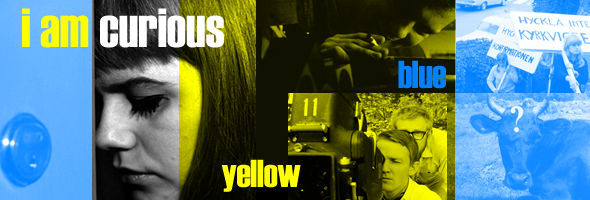 by the film, many obscenity and pornography laws were lifted, allowing softcore to enter the mainstream. The blurring of documentary and narrative also proved to be influential, as our impressions of the actors versus characters are often unreliable. Ahlstedt turns out to be the father of another woman's child, but we have no idea whether this is fact or part of the film's construct; Nyman is the director's lover but falls for the leading actor, yet we cannot tell where the acting ends and the genuine change of heart begins. As a result the sex scenes have an increased emotional impact, and in Blue when they have become domesticated yet remain active in political protests, the viewer is pulled along for the journey as well. Many viewers also associate Swedish cinema with austere, serious subject matter (often unfairly, as Ingmar Bergman actually did several whimsical projects). Here humor is integrated skillfully into the interviews and situations in a realistic fashion; Sjöman also uses effect cutaways to written messages and visual collages to drive his points home with wry aplomb.
by the film, many obscenity and pornography laws were lifted, allowing softcore to enter the mainstream. The blurring of documentary and narrative also proved to be influential, as our impressions of the actors versus characters are often unreliable. Ahlstedt turns out to be the father of another woman's child, but we have no idea whether this is fact or part of the film's construct; Nyman is the director's lover but falls for the leading actor, yet we cannot tell where the acting ends and the genuine change of heart begins. As a result the sex scenes have an increased emotional impact, and in Blue when they have become domesticated yet remain active in political protests, the viewer is pulled along for the journey as well. Many viewers also associate Swedish cinema with austere, serious subject matter (often unfairly, as Ingmar Bergman actually did several whimsical projects). Here humor is integrated skillfully into the interviews and situations in a realistic fashion; Sjöman also uses effect cutaways to written messages and visual collages to drive his points home with wry aplomb.
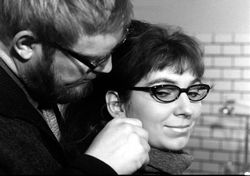 Criterion's two-disc boxed set presents each film in its own separate case, with seprate extras relating to each title. Transferred from the original negatives in their original 1.33:1 aspect ratio, both films look absolutely pristine. Anyone accustomed to battered repertory prints or, even worse, hazy video transfers with unreadable, bleached-out subtitles will be amazed by the visual presentation here. Black levels are dead on, and detail is immaculate and crystal clear. The optional English subtitles are much more literate and easy to follow than earlier versions, which consequently makes the films easier to digest as the imagery whizzes by.
Criterion's two-disc boxed set presents each film in its own separate case, with seprate extras relating to each title. Transferred from the original negatives in their original 1.33:1 aspect ratio, both films look absolutely pristine. Anyone accustomed to battered repertory prints or, even worse, hazy video transfers with unreadable, bleached-out subtitles will be amazed by the visual presentation here. Black levels are dead on, and detail is immaculate and crystal clear. The optional English subtitles are much more literate and easy to follow than earlier versions, which consequently makes the films easier to digest as the imagery whizzes by.
